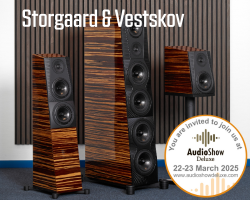iFi’s new wireless music system, the Aurora, brings together a collection of proprietary technologies to deliver, say iFi “a sonic experience unlike any other tabletop, all-in-one system”.
Clad in bamboo and elevated by a distinctive aluminium frame, the Aurora’s design is rather striking. The aesthetic was created by French product designer Julien Haziza, inspired by the architecture in Tokyo’s Omotesandō and Harajuku districts. Six drive units nestle behind the bamboo fins that curve around the Aurora’s sides, with a further two bass radiators underneath. The system’s control panel sits front and centre, with touch-sensitive controls and an OLED display inlaid with bamboo.
Read on for more technical info about the iFi Aurora, but also check out our impressions of hearing it for the first time at the High End Munich 2019 launch here.
Aurora Borealis
The Aurora’s name is inspired by its sound. iFi say: “It delivers a remarkably expansive soundstage, tailored to the space in which it sits. It fills the room with sound as the Aurora Borealis fills the sky with light, electrifying your music and immersing you in the performance of your favourite artists”.
Well Connected
The Aurora connects to a home Wi-Fi network, enabling users to stream music via their favourite apps, or play audio files stored on networked devices such as computers and NAS drives. Bluetooth is also included, so that users may stream directly from any smart device.
The Aurora is hi-res audio enabled, supporting data up to 32-bit/192kHz without conversion or down-sampling via Wi-Fi, USB or Ethernet cable. Bluetooth streaming also delivers much better sound quality than is typically the case, engineered by iFi to be less ‘lossy’ than off-the-shelf Bluetooth solutions. The latest high-quality Bluetooth codecs are supported, including aptX HD, LDAC and LDHC, as well as AAC. Connecting to a Wi-Fi network couldn’t be simpler, with push-button WPS set-up. Linkplay’s MUZO Player app – or any UPnP/DLNA streaming app – may be used to configure the system and control music. AirPlay and Spotify Connect are also supported. Several Auroras may be linked together on a Wi-Fi network to make a seamless multi-room system, playing in-sync or controlled individually.
Music Amplified By PureEmotion
At the Aurora’s heart lies proprietary amp technology that iFi calls ‘PureEmotion’ – a hybrid circuit design comprising several key stages. The first of these – the preamp stage – incorporates a Russian 6N3P valve (visible through a window next to the OLED display). This takes the analogue audio signal delivered by the Aurora’s DAC (Digital-to-Analogue Converter) circuitry, based around a chip from ESS Technology’s renowned 32-bit Sabre DAC family, and adds gain in preparation for further amplification, imbuing the sound with pure tonality, open imaging and natural fluidity. The resulting low-level signal then passes to the power amp stage, iFi’s ‘current multiplier circuit’. This is a highly efficient switching power amplifier, a description it has in common with Class D amplification, but there the similarity ends.
Class D amp modules are often used in audio products because they are energy efficient and able to generate relatively high current from a small device. However, in terms of sound quality, typical ‘off-the shelf’ Class D amps can leave a lot to be desired, not least because switching occurs at varying frequencies which may be within the audible range, the higher the power level, the lower the switching frequency.
iFi’s current multiplier circuit is entirely different because the switching frequency is fixed at an ultra-high level, around 1.5MHz, far beyond the audible frequency spectrum. This results in a high level of efficiency, multiplying the current supplied by the valve several thousand-fold, whilst maintaining far greater linearity and lower noise than typical switching amplifiers. Coupled to this is a low-pass circuit and a feedback loop, the latter ensuring the output frequency is ideal for the load, and everything is ‘clock-locked’ via iFi’s GMT (Global Master Timing) circuit to ensure precision.
Custom Drivers
The PureEmotion amp stage delivers a total of 320W to power the Aurora’s custom-made speaker drive units. The main drivers, of which there are four , two firing from the front and one from each side, sport a 120mm cone made from coated long-fibre paper, a material selected for its optimal balance between stiffness and self-damping. This is coupled to a large magnet, a basket that resonates above the audible range and extensive measures to ensure excursion is controlled and damped mechanically, so that clarity and control are maintained even at high volume levels. Unusually, these main drivers are deployed in a wide-bandwidth role to cover the vast majority of the audible frequency spectrum, rolling off towards very low and very high frequencies. The drive unit design, together with the inert nature of the Aurora’s housing enables a flat frequency response from around 60Hz to 8kHz, avoiding the need for a crossover to hand over from one drive unit to another at critical Frequencies.
Super-Tweeters
Two 28mm silk-dome tweeters, one at each side, cover frequencies from 8kHz to 35kHz. As the treble region is considered to begin at around 5kHz, and the limits of human hearing extend to about 20kHz, the Aurora’s high-frequency drivers behave more like super-tweeters than traditional tweeters. With a simple first-order crossover for the smoothest-possible transition and a shallow waveguide to provide time-alignment, these tweeters not only deliver high-frequency but are also critical to the Aurora’s spacious soundstage.
Passive Bass Radiators
Two further drivers, a pair of rectangular passive bass radiators, fire downwards from the underside of the cabinet. The diaphragm used by these drivers is formed from a composite of carbon, iron and ethylene-vinyl acetate, a well-damped material enabling the correct resonant frequency to be obtained from a diaphragm of appropriate thickness. This is combined with a elf-centring, double-ribbed rubber surround, negating the need for a basket.
SoundSpace And TrueBass
There are plenty of audio products on the market that claim to deliver a big, spacious, three-dimensional performance from a single box. Many of these use DSP (Digital Signal Processing) to manipulate the digital data in order to achieve this effect. iFi does not use DSP of this kind in any of its products; instead, the Aurora incorporates sound-tuning technologies that operate entirely in the analogue domain. SoundSpace is one such technology – this combines the drive unit array with a proprietary matrix, which adjusts the output from specific drivers at certain frequencies. TrueBass is another proprietary sound-tuning technology that operates strictly in the analogue domain.
ART (Automatic Room Tailoring)
The Aurora incorporates a ‘room correction’ system called ART (Automatic Room Tailoring), entirely developed in-house by iFi. At the press of a button, six ultrasonic sensors measure the distance to the surrounding walls using ultrasound. Then, a 32-bit ARM Cortex microprocessor adjusts the output from the driver array to precisely tailor Aurora’s performance. The effect is similar to the adjustments made by a live sound engineer at a mixing desk when adapting sound to suit different venues.
All the adjustments are made strictly in the analogue domain, without relying on DSP or feedback in the manner of many other room correction systems. This enables much finer and more accurate tailoring of the sound, reacting to room modes and reflections from walls without attempting to ‘neutralise’ the sound in an unnatural way.
Cable Inputs
In addition to wireless connectivity, there are plenty of cable inputs to connect source devices. Optical, coaxial, USB and Ethernet inputs cater for digital sources, while 3.5mm socket provides an analogue input. There is even a slot for microSDHC cards. One thing that isn’t built into the Aurora is voice control. Integrating Alexa, for example, would have compromised performance, both in terms of limiting audio resolution to 16-bit/48kHz and re-focusing the design to prioritise the audibility of voice commands over outright sound quality. However, those who wish to incorporate Alexa may do so easily, by linking the Aurora (or several Auroras in a multi-room context) to any Echo speaker, from the Input upwards, via Wi-Fi or Bluetooth.
Available from August at an RRP of £1,299 including VAT.
READ MORE HIFI NEWS WITH HIFI PIG























































































































































































You must be logged in to leave a reply.